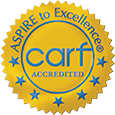A song comes on the radio that you first heard while using. Or a person you once partied with walks out of the grocery store as you arrive. It can be as innocent as the straw a waitress sets next to your iced tea. Any of these people, places or things can trigger memories from when you used. These triggers in substance abuse lead to a craving. A craving is an intense feeling in which you suddenly want or need the drug. Triggers in substance abuse can lead you right back where you started.
Trigger ⇒ Thought ⇒ Craving
Triggers in substance abuse are everywhere. At Pax House, you’ll learn them, and then learn to avoid them when appropriate.
For instance, the smell of incense for one addict triggers memories of houses and drug-fueled parties, so for the first year of his recovery, they had to get rid of all the incense in their apartment. For people who smoked cigarettes while high, smoking can be a troublesome trigger. The good news is that triggers often become less potent over time. The certain song that, in your first month, sent you into a mad craving tizzy may, after several more months, lose its power over you. With time, the potency of your triggers and the cravings mellow.
Successfully quitting meth has a lot to do with learning how to check these cravings and interrupt the sequence of Trigger-Thought-Craving-Use. Just know these triggers and cravings are to be expected. Don’t worry—they can be dealt with successfully without relapsing. The fact is that triggers in substance abuse and cravings are part of recovery.
Kinds of Triggers in Substance Abuse
External triggers. These are things outside of you that trigger a using thought. Like a text from an old using buddy. Or the neighborhood where your dealer lived.
Internal triggers. These are triggers that originate from within you, usually emotions. Some people are triggered to use when very sad or depressed. You just want the low to be wiped away by the euphoria of the drug. Others get triggered by just the opposite—joy and excitement. When something good happens, their disease tells them: “This is so great! Let’s get high to celebrate and make this greatness last longer!”
Some people are triggered when they feel misunderstood, criticized or ignored. Others when they get deeply angered, irritated, or feel embarrassed. Just about any strong emotion can be a trigger for you to use—if you associate using with it. Discover which emotional states trigger you the strongest.
Stop the Thought
One successful strategy to halt the trigger from going further is to “stop the thought” dead in its tracks before you arrive at the craving. You interrupt the sequence of thought-craving before the thought part can turn into a full-fledged craving. There are many ways to do this and I encourage you to find those that work best for you.
Here are some additional ideas.
Visualize the “thought” as a TV screen image, and then change the channel. Picture the image of that using thought on a TV screen inside your mind. Then visualize yourself changing the channel of that inner TV. Pick a positive, happy image for the new channel—say, the image of someone you love dearly, hugging you. Or your favorite view of the ocean. Something powerful that instantly elicits happy feelings. So, you visualize this channel switch in your mind, and the new positive image appears on that inner TV screen.
Think of something that evokes a powerful emotion, like anger—but has no associations with using. One recovering addict told me he “stopped the thought” by immediately thinking of a certain politician who made him furious. Just rekindling his anger toward this politician (or political party) was enough to get his mind completely off using for the moment. Who knew politics could be put to such good use? Think of your family… I keep their picture on my phone screen so it is an instant reminder, Why? I won’t ever go there again!!
Snap that rubber band on your wrist. If the stop-the-thought process isn’t working for you, try a pre-planned action that interrupts the thought. Some alcohol rehab centers in los angeles advise you to wear a rubber band around your wrist so that, whenever you catch yourself thinking about using, you can snap the rubber band. This jogs your thinking process and stops the forward momentum toward craving and use. The sting of the rubber band on your wrist brings your thoughts back to the present moment.
These are just a few. Find your own and stop that thought before it becomes a craving.
In the meantime, be well, keep clean and, remember, don’t pick up without calling a non-using friend first. Sharing your thought of using aloud is another powerful way to stop the process.
We usually don’t get clean by ourselves. It takes a team!

